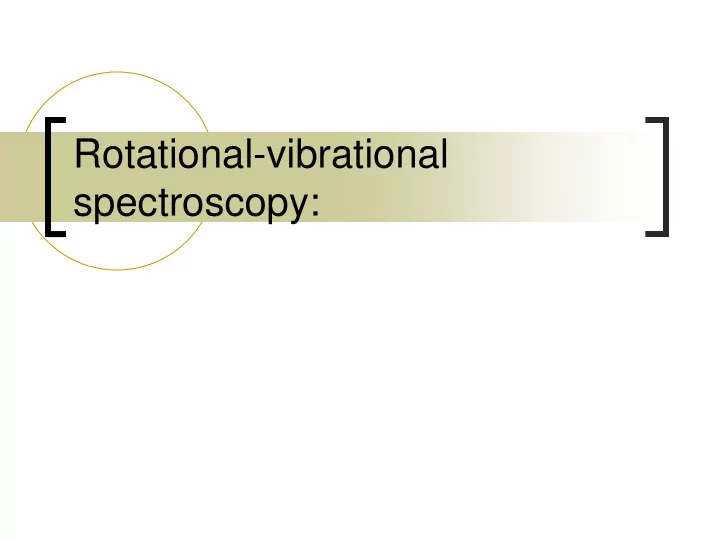

Rotational-vibrational spectroscopy:
Rotation and Vibration Rotational-vibrational spectroscopy Energy states provided by sum of rotational and vibrational energy: Ẽn,J = ṽ ( n +1/2) + B̃ J(J+1) CO spectrum Selection rules Molecular Spectroscopy CEM 484 2
Rotation and Vibration Rotational-vibrational spectroscopy Energy states provided by sum of rotational and vibrational energy: n =3 J=3 Ẽ n ,J = ṽ ( n +1/2) + B̃ J(J+1) n =2 J=2 n =1 J=1 J=0 n =0 Molecular Spectroscopy CEM 484 3
Rotation and Vibration Simple equation suggests equal spacing on either side of ṽ = 0. Spacing is clearly not equal P branch separation increase R branch decreases Molecular Spectroscopy CEM 484 4
Iclicker: Rotation and Vibration Which class of transitions is responsible for the series of lines above 0.3175 ev? A – 1 B – 2 C – neither D - both n =1 J=3 J=2 J=1 J=0 n =0 1 2 Molecular Spectroscopy CEM 484 5
Rotation and Vibration Spacing is clearly not equal (1) Rotational constant is not independent of vibration B ̃ = h/8 p 2 cI = h/8 p 2 c m r 2 B ̃ n = B ̃ e – a ̃ e ( n +1/2) n ̃ P = E n =1,J-1 /hc – E n =0,J /hc = 3/2* n ̃ o + B̃ 1 [(J-1)J] – n o /2 – B̃ o [J(J+1)] n ̃ P = n ̃ o + B̃ 1 J 2 – B̃ 1 J – B̃ o J 2 – B̃ o J n ̃ P = n ̃ o – (B̃ 1 + B̃ o )J – ( B̃ o – B̃ 1 )J 2 - + B̃ 1 < B̃ 0 ,as J increases spacing increases n ̃ R = n ̃ o + 2B̃ 1 + (3B̃ 1 - B̃ o )J + (B̃ 1 – B̃ 0 )J 2 Molecular Spectroscopy CEM 484 6
Rotation and Vibration Spacing is clearly not equal (2) Even in pure rotational spectrum, spacing is not equal Centrifugal stretching reduces I, small correction Correction to rotational energy equation. F(J) = B̃ n [J(J+1)] – D̃ J 2 (J+1) 2 D̃ is centrifugal distortion constant D ̃ << B ̃ n – typically by 4-6 orders of magnitde Molecular Spectroscopy CEM 484 7
Anharmonicity and Overtones Harmonic oscillator is only an approximation Excitations not allowed under approximation. n = 0 → 1 – fundamental n = 0 → 2 – first overtone n = 0 → 3 – second overtone 1 H 35 Cl n = 0 → 1 – 2885.8 cm -1 n = 0 → 2 – 5668.0 cm -1 n = 0 → 3 – 8347.0 cm -1 Molecular Spectroscopy CEM 484 8
Anharmonicity and Overtones Correct harmonic oscillator by retaining higher-order terms in potential. V = ½ k * (R-R e ) 2 + g 3 /6 * (R-R e ) 3 … E n = { ( n +1/2) n ̃ e – x e n ̃ e ( n + ½) 2 }hc x e is anharmonicity constant. Divide by hc to get wavenumber E n /hc = G( n ) = { ( n +1/2) n ̃ e – x e n ̃ e ( n + ½) 2 } = E n = { ( n +1/2) n ̃ e – x e n ̃ e ( n + ½) 2 }hc Fundamental and overtone found at: D G = G n – G( n =0) = ( n +1/2) n ̃ e – ( n +1/2) 2 x e n ̃ e – n e /2 + x e n ̃ e /4 n * n ̃ e – ( n 2 + n +1/4-1/4)x e n ̃ e = n * n ̃ e – n ( n +1)x e n ̃ e Molecular Spectroscopy CEM 484 9
Iclicker: Intensities What is the origin of the intensity variation in the P branch? A – varying equilibrium bond distances B – breakdown of rotational selection rule C – breakdown of vibrational selection rule D – unequal thermal populations E – the photon detection efficiency varies as a function of energy Molecular Spectroscopy CEM 484 10
Recommend
More recommend